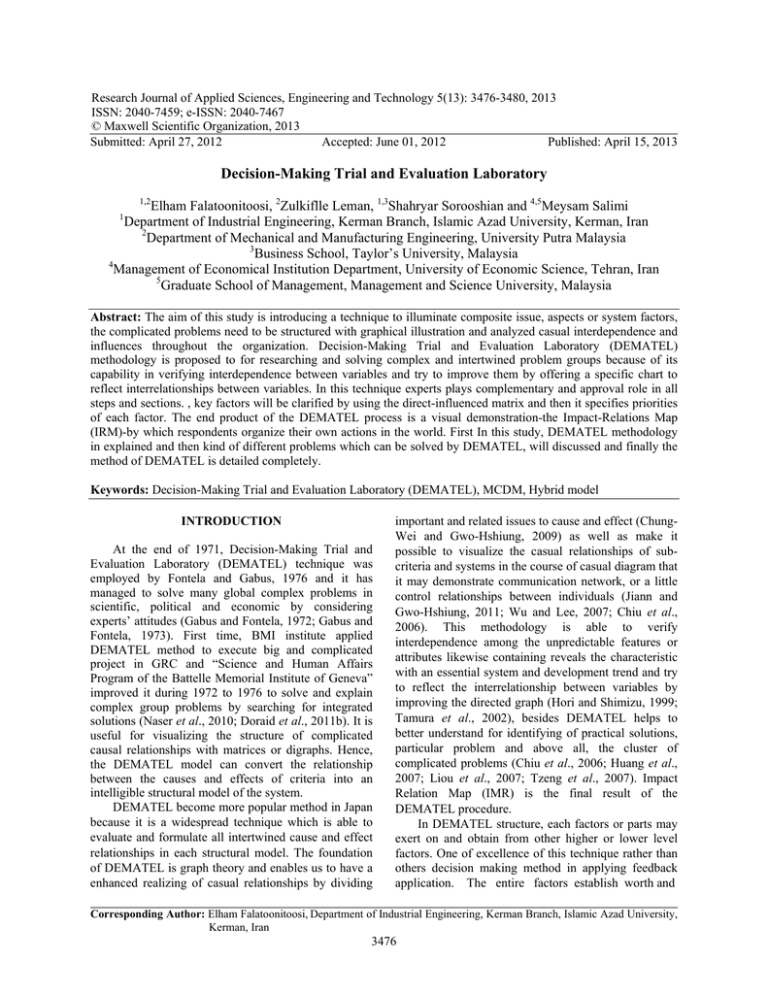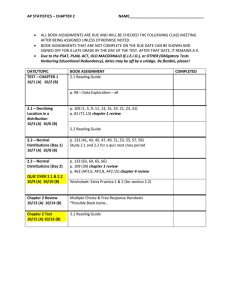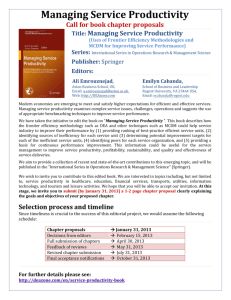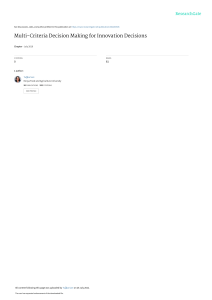Research Journal of Applied Sciences, Engineering and Technology 5(13): 3476-3480,... ISSN: 2040-7459; e-ISSN: 2040-7467
advertisement

Research Journal of Applied Sciences, Engineering and Technology 5(13): 3476-3480, 2013 ISSN: 2040-7459; e-ISSN: 2040-7467 © Maxwell Scientific Organization, 2013 Submitted: April 27, 2012 Accepted: June 01, 2012 Published: April 15, 2013 Decision-Making Trial and Evaluation Laboratory 1,2 Elham Falatoonitoosi, 2Zulkiflle Leman, 1,3Shahryar Sorooshian and 4,5Meysam Salimi Department of Industrial Engineering, Kerman Branch, Islamic Azad University, Kerman, Iran 2 Department of Mechanical and Manufacturing Engineering, University Putra Malaysia 3 Business School, Taylor’s University, Malaysia 4 Management of Economical Institution Department, University of Economic Science, Tehran, Iran 5 Graduate School of Management, Management and Science University, Malaysia 1 Abstract: The aim of this study is introducing a technique to illuminate composite issue, aspects or system factors, the complicated problems need to be structured with graphical illustration and analyzed casual interdependence and influences throughout the organization. Decision-Making Trial and Evaluation Laboratory (DEMATEL) methodology is proposed to for researching and solving complex and intertwined problem groups because of its capability in verifying interdependence between variables and try to improve them by offering a specific chart to reflect interrelationships between variables. In this technique experts plays complementary and approval role in all steps and sections. , key factors will be clarified by using the direct-influenced matrix and then it specifies priorities of each factor. The end product of the DEMATEL process is a visual demonstration-the Impact-Relations Map (IRM)-by which respondents organize their own actions in the world. First In this study, DEMATEL methodology in explained and then kind of different problems which can be solved by DEMATEL, will discussed and finally the method of DEMATEL is detailed completely. Keywords: Decision-Making Trial and Evaluation Laboratory (DEMATEL), MCDM, Hybrid model important and related issues to cause and effect (ChungWei and Gwo-Hshiung, 2009) as well as make it possible to visualize the casual relationships of subcriteria and systems in the course of casual diagram that it may demonstrate communication network, or a little control relationships between individuals (Jiann and Gwo-Hshiung, 2011; Wu and Lee, 2007; Chiu et al., 2006). This methodology is able to verify interdependence among the unpredictable features or attributes likewise containing reveals the characteristic with an essential system and development trend and try to reflect the interrelationship between variables by improving the directed graph (Hori and Shimizu, 1999; Tamura et al., 2002), besides DEMATEL helps to better understand for identifying of practical solutions, particular problem and above all, the cluster of complicated problems (Chiu et al., 2006; Huang et al., 2007; Liou et al., 2007; Tzeng et al., 2007). Impact Relation Map (IMR) is the final result of the DEMATEL procedure. In DEMATEL structure, each factors or parts may exert on and obtain from other higher or lower level factors. One of excellence of this technique rather than others decision making method in applying feedback application. The entire factors establish worth and INTRODUCTION At the end of 1971, Decision-Making Trial and Evaluation Laboratory (DEMATEL) technique was employed by Fontela and Gabus, 1976 and it has managed to solve many global complex problems in scientific, political and economic by considering experts’ attitudes (Gabus and Fontela, 1972; Gabus and Fontela, 1973). First time, BMI institute applied DEMATEL method to execute big and complicated project in GRC and “Science and Human Affairs Program of the Battelle Memorial Institute of Geneva” improved it during 1972 to 1976 to solve and explain complex group problems by searching for integrated solutions (Naser et al., 2010; Doraid et al., 2011b). It is useful for visualizing the structure of complicated causal relationships with matrices or digraphs. Hence, the DEMATEL model can convert the relationship between the causes and effects of criteria into an intelligible structural model of the system. DEMATEL become more popular method in Japan because it is a widespread technique which is able to evaluate and formulate all intertwined cause and effect relationships in each structural model. The foundation of DEMATEL is graph theory and enables us to have a enhanced realizing of casual relationships by dividing Corresponding Author: Elham Falatoonitoosi, Department of Industrial Engineering, Kerman Branch, Islamic Azad University, Kerman, Iran 3476 Res. J. Appl. Sci. Eng. Technol., 5(13): 3476-3480, 2013 Create the directinfluenced matrix Normalizin g directinfluenced matrix Achieve the totalrelation matrix Raw data from experts’s opinions Get the casual diagram Obtain the impact relationship map Fig. 1: Illustrate steps of DEMATEL in a diagram importance of factors instead of considering only specific factors (Fontela and Gabus, 1976). The main objective of this study is nominating a MCDM method for solving complicated issues and for evaluating, comparing and improving the effectiveness of every system factors by dividing all factors into cause and effect group. Actually, DEMATEL technique is able to visualize interdependencies among the unpredictable aspects by representing direct relationship map (Fig. 1) (Elham et al., 2012). Also the strange of influence of each factor is demonstrated as numerical and it manages to find that which factors have more effects on other factor. Therefore, by improving the case group, effect group will be improved easily. In fact, aspects in effect group are tend to be simply influenced by others features in cause group. As a result, this methodology enables business managers to reach a high performance regarding to the effect group criteria in all fields. Evaluating Sustainable Supplier (Chiou et al., 2011), prioritizing distribution centers in supply chain (Amiri et al., 2011) Besides the results from final step of DEMATEL (IRM) could be used in fuzzy approach to evaluate the super additive efficiency rate After determining the interrelations between criteria and also it could be combined with another multi criteria decision making methods like Analytic Hierarchy Process (AHP), Analytic Network Process method (ANP) (Saaty, 1996; Tsai and Chou, 2009) to quantify dependence and feedback relationships between certain criteria, VIKOR and Technique for Order Performance by Similarity to Ideal Solution (TOPSIS). in these cases the final decision will be effected by DEMATEL result while it is applied as a part of hybrid MCDM model. Previous studies in DEMATEL: Furthermore DEMATEL technique has been applied in various situation, ranging from manufacturing planning and control to multi criteria decision making and analyzing world challenging such as administration control systems (Hori and Shimizu, 1999) Marketing strategy and customer performance (Chiu et al., 2006), safety and security measurement (Liou et al., 2007), fuzzy approach and expert systems (Wu and Lee, 2007; Lin and Wu, 2008), modernization strategy set for Taiwan’s SIP Mall (Huang et al., 2007). Success factors of hospital service quality (Jiunn-I et al., 2010) and industry material selection process (Shih-Chi et al., 2011). DEMATEL method is the most important application that is applied in the multi-criteria decision making (MCDM) field to visualize and construct interrelations between criteria and sub-criteria as such as, Evaluating Green Suppliers and Selecting Green Supplier (Ru-Jen, 2011; Shahryar et al., 2012), The DEMATEL method: For applying DEMATEL, there are 5 main step: making the direct-influenced matrix calculating the direct-influenced matrix normalization achieving the total-relation matrix Producing a causal diagram Obtaining the inner dependence matrix and impact relationship map Obtaining the inner dependence matrix. In this step, the sum of each column in total-relation n×n matrix is equal to 1 by the normalization method and then the inner dependence matrix can be acquired. The procedures of the DEMATEL method can be expressed as follow: Step 1: Finding the direct-relation (Average) matrix. : At first we have four scales that determine the values of relationships between different factors according to the experts’ opinion. 3477 Res. J. Appl. Sci. Eng. Technol., 5(13): 3476-3480, 2013 0 1 2 3 = no influence = low influence = high influence = very high influence There are H experts and n factor (criteria) to be considered. Each expert answer the certain questions to illustrate the degree of a criterion i effect criterion j due to her or his beliefs. For now aij donates pair wise comparisons between any two criteria and it is assigned integer score ranging from 0, 1, 2, 3, 4. The scores are … are answers given by each expert and non-negative matrix each of them that make the , with 1<k<H. A high score indicates a belief that greater improvement in i is required to improve j. Then it’s possible to calculate the average matrix A on account of all expert’s opinions by averaging the H their scores as follows: ∑ (1) The average matrix is also called the initial direct-influenced matrix which indicates the initial direct effects each criterion exerts on and receive from other criteria. Moreover in this step, obtaining the causal effect between each pair of criteria in a system by drawing an influence map will be possible. Also as follows: If aij ≤ 1 Independent is identified among all criteria; otherwise, non‐independent will be identified The structural relations between the criteria of a system are converted to intelligible and logical map of the system. Figure 2 shows an example of such a network influence map which helps to explain the represents a criterion in the structure of the factors. system. As an instance the arrow from to indicate the effect that on and the power of its effect is 3. Step 2: Normalize the initial direct-relation matrix. By normalizing the average matrix A, normalized initial direct relation matrix D is obtained in the following formulate: max max ∑ aij , max ∑ aij Fig. 2: Example of network influence map (3) D Consequently total direct effects that criterion i gives to the other criteria is obtained by sum of each row i of matrix A as well as the sum of each column j represent most direct effects on others by total direct effects of the criterion. “Likewise, since the sum of each column j of matrix A represents the total direct effects received to other criteria by criterion i, max ∑ aij represents the total direct effects that the criterion j receives the most direct effects from other criteria and The positive numerical s takes the smaller of the two as the upper bound and the matrix D is obtained by dividing each element of A by the scalar s.” (Jiann and Gwo-Hshiung, 2011). Each element dij of 1. matrix D is between zero and less than 1: 0 Step3: Calculate the total-relation matrix. A continuous reducing of the indirect effects of problems beside the powers of matrix D, like to an engrossing Markov chain matrix, guarantees convergent solutions to the matrix inversion. Note that: , lim ,…, 0 →∞ ∞ 0 is achieved as The total relation matrix follow: ∑∞ … ⋯ ) ⋯ (2) 3478 1 ) (4) Res. J. Appl. Sci. Eng. Technol., 5(13): 3476-3480, 2013 Table 1: Review of hybrid models Year Hybrid model 2011 DEMATEL, ANP, TOPSIS under fuzzy environmet 2011 DEMATEL, ANP 2011 DEMATEL, ANP, VIKOR 2011 DEMATEL, ANP, VIKOR 2011a DEMATEL ,TOPSIS 2010 DEMATEL,ANP, BSC 2009 DEMATEL. ANP, ZOGP I: Identity matrix T: Total relation matrix ( Title A novel hybrid MCDM approach based on fuzzy DEMATEL, fuzzy ANP and fuzzy TOPSIS to evaluate green suppliers An integrated MCDM technique combined with DEMATEL for a novel cluster-weighted with ANP method Brand marketing for creating brand value based on a MCDM model combining DEMATEL with ANP and VIKOR methods A VIKOR technique based on DEMATEL and ANP for information security risk control assessment A fuzzy multi-criteria decision making model for supplier selection Enhancing the Performance of a SOC Design Service Firm by Using a Novel DANP Based MCDM Framework on the Balanced Scorecard Selecting management systems for sustainable development in SMEs: A novel hybrid model based on DEMATEL, ANP and ZOGP Aim Evaluating green supplier Authors Gülçin and Gizem Using average method (equal cluster-weighted) to obtain the weighted supermatrix Evauating brand marketing Jiann and GwoHshiung Information security risk control assessment Yu-Ping et al. Yung-Lan and Gwo-Hshiung Doraid et al. Improving the Performance of a SOC Design Service Sustainable development Chi-Yo et al. Wen-Hsien and Wen-Chin CONCLUSION ) The sum of rows and sum of columns of the total relation matrix T are computed as an r and c 1 vectors. ∑ (5) ∑ (6) . demonstrates the total effects, both direct and indirect, given by criterion i to the other criteria j = represents total effects, 1, 2, ... , n, similarity direct and indirect, received by criterion j from the other criteria i = 1, 2, ...,n As a result, while i = j the sum (ri + ci) that is called “Prominence’’ proves the degree of importance role of criterion i in system and also gives an index that shows the total effects both given and received by criterion i. likewise , the (ri ci) that in called “Relation” shows the net effect that criterion i donates to the system. When (ri ci) is positive, criterion i will be to the cause group and when (ri ci) is negative, criterion i is a net receiver. Hybrid MCDM DEMATEL: DEMATEL technique has combined with other MCDM methods such as AHP, ANP, VIKOR and TOPSIS. As fallow some of this hybrid models are reviewed in recent years. (Table 1). This study highlights a flexible and effective decision making method which is DEMATEL, according to a novel hybrid MCDM practices. This study is based on the target values of a review algorithm with emphasize on compromise solution in hybrid decision making methods as well as criteria interrelationship studies. Results of DEMATEL applied examples showed the potential of this method in MCDM, so it can help designers and decision makers for acquiring more strong decisions. REFERENCES Amiri, M., S.S. Jamshid, P. Nafiseh and S. Mahdi, 2011. Developing a DEMATEL method to prioritize distribution centers in supply chain. Manage. Sci. Lett., 10(3-4): 279-288. Chiou, C.Y., H.C. Chen and C.W. Hsu, 2011. Using DEMATEL to explore a casual and effect model of sustainable supplier selection. IEEE, 4(2): 240-244. Chi-Yo, H., C. Hueiling, T. Gwo-Hshiung and H. Kuang-Hua, 2010. Enhancing the Performance of a SOC design service firm by using a novel DANP Based MCDM framework on the balanced scorecard. IEEE, 1-6. Chiu, Y.J., H.C. Chen, J.Z. Shyu and G.H. Tzeng, 2006. Marketing strategy based on customer behavior for the LCD-TV. Int. J. Manage. Decision Making, 7(2-3): 143-165. 3479 Res. J. Appl. Sci. Eng. Technol., 5(13): 3476-3480, 2013 Chung-Wei, L. and T. Gwo-Hshiung, 2009. Identification of a threshold value for the DEMATEL method using the maximum mean deentropy algorithm to find critical services provided by a semiconductor intellectual property mall. Expert Syst. Appl., 8(1): 9891-989. Doraid, D., H. Mohammed and B. Farhan, 2011a. A fuzzy multi-criteria decision making model for supplier selection. Exp. Syst. Appl., 8(2): 8384-8391. Doraid, D., H. Mohammed and B. Farhan, 2011b. A fuzzy multi-criteria decision making model for supplier selection. Exp. Syst. Appl., 38: 8384-8391. Elham, F., L. Zulkiflle and S. Shahryar, 2012. Casual strategy mapping using integrated BSC and MCDM-DEMATEL. J. Am. Sci., 8(5). Fontela, E. and A. Gabus, 1976. The DEMATEL observer, DEMATEL 1976 report. Battelle Geneva Research Center, Switzerland Geneva. Gabus, A. and E. Fontela, 1972. World Problems an Invitation to Further Thought within the Framework of DEMATEL. Battelle Geneva Research Centre, Switzerland, Geneva. Gabus, A. and E. Fontela, 1973. Perceptions of the World Problematique: Communication Procedure, Communicating with those Bearing Collective Responsibility. Gülçin, B. and Ç. Gizem, 2011. A novel hybrid MCDM approach based on fuzzy DEMATEL, fuzzy ANP and fuzzy TOPSIS to evaluate green suppliers. Exp. Syst. Appl., 39(3): 3000-3011. Hori, S. and Y. Shimizu, 1999. Designingmethods of human interface for supervisory control systems. Control Eng. Pract., 7(11): 1413-1419. Huang, C.Y., J.Z. Shyu and G.H. Tzeng, 2007. Reconfiguring the innovation policy portfolios for Taiwan's SIP Mall industry. Technovation, 27(12): 744-765. Jiann, L.Y. and T. Gwo-Hshiung, 2011. An integrated MCDM technique combined with DEMATEL for a novel cluster-weighted with ANP method. Expert Syst. Appl., 7(2): 1417-1424. Jiunn-I, S., W. Hsin-Hung and H. Kuan-Kai, 2010. A DEMATEL method in identifying key success factors of hospital service quality. Knowl-Based Syst. Arch., 23(1): 277-282. Lin, C.J. and W.W. Wu, 2008. A causal analytical method for group decision-making under fuzzy environment. Exp. Syst. Appl., 34(1): 205-213. Liou, J.J.H., G.H. Tzeng and H.C. Chang, 2007. Airline safety measurement using a hybrid model. J. Air Transp. Manag., 13(4): 243-249. Naser, B.M., S. Mahdi, S.A. Amir, Y. Hami and H.H. Seyed, 2010. Strategic environment analysis using DEMATEL method through systematic approach. Manage. Sci. Eng., 11(2-3): 95-105. Ru-Jen, L., 2011. Using fuzzy DEMATEL to evaluate the green supply chain management practices. J. Clean. Prod., 8(3): 1-8. Saaty, T.L., 1996. Decision making with dependence and feedback: Analytic network process. RWS Publication, Pittsburgh. Shahryar, S., A. Aireza, S. Meysam and F. Elham, 2012. Interrelation study of entrepreneur’s capability. World Appl. Sci. J., 17(7): 818-820. Shih-Chi, C., C.C. Sun and A. Herchan, 2011. The DEMATEL approach applied to solar cell industry material selection process in Taiwan. Session Interd. Manage. Sem., 15(13): 253-267. Tamura, M., H. Nagata and K. Akazawa, 2002. Extraction and systems analysis of factors that prevent safety and security by structural models. In 41st SICE Annual Conference, Osaka, Japan. Tsai, W.H. and W.C Chou, 2009. Selecting management systems for sustainable development in SMEs: A novel hybrid model based on DEMATEL, ANP and ZOGP. Exp. Syst. Appl., 36(2): 1444-1458. Tzeng, G.H., C.H. Chiang and C.W. Li, 2007. Evaluating intertwined effects in e-learning programs: A novel hybrid mcdm model based on factor analysis and DEMATEL. Exp. Syst. Appl., 32(4): 1028-1044. Wen-Hsien, T. and C. Wen-Chin, 2009. Selecting management systems for sustainable development in SMEs: A novel hybrid model based on DEMATEL, ANP and ZOGP. Exp. Syst. Appl., 36: 1444-1458. Wu, W.W. and Y.T. Lee, 2007. Developing global managers’ competencies using the fuzzy DEMATEL method. Exp. Syst. Appl., 32(2): 499-507. Yung-Lan, W. and T. Gwo-Hshiung, 2011. Brand marketing for creating brand value based on a MCDM model combining DEMATEL with ANP and VIKOR methods. Exp. Syst. Appl., 16(3). Yu-Ping, O.Y., S. How-Ming and T. Gwo-Hshiung, 2011. A VIKOR technique based on DEMATEL and ANP for information security risk control assessment. Inform. Sci., In Press. 3480



